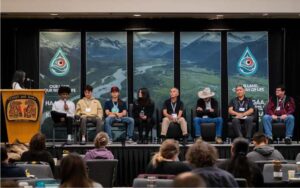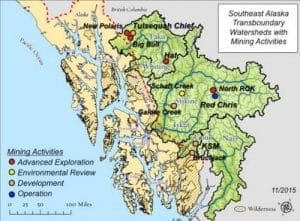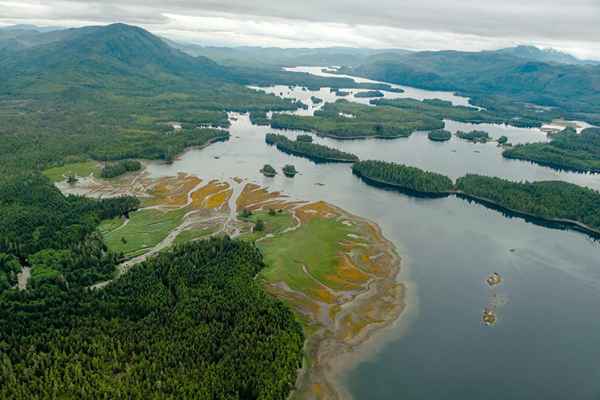
JUNEAU, AK – Protecting the lands and waters that have sustained our peoples for countless generations is a shared responsibility. For Indigenous people, the work is done to ensure our children inherit a world where our cultures thrive, our sovereign rights are respected, and our voices are heard. These sentiments echoed throughout the Indigenous-led Transboundary Mining conference hosted last week by Tlingit & Haida.
Indigenous leaders from Alaska, Washington, Idaho, Montana, and British Columbia, community allies, as well as government officials from the United States and Canada, gathered in Juneau, Alaska to explore lessons learned and a shared-governance approach to protecting and remediating damage done to transboundary rivers. More than 175 people joined Tlingit & Haida from across North America.
Just beyond the political border from Southeast Alaska, the threat of contamination within shared watersheds from poorly regulated mining in British Columbia has become more real over the last decade. More than 30 large-scale gold and copper mines are in advanced stages of exploration, development, and operation, or already abandoned and contaminating the headwaters of rivers. This issue is not unique to Southeast Alaska; British Columbia mines are also actively impacting rivers that flow across the arbitrary border into the traditional territories of tribes in Washington, Idaho, and Montana, and without free, prior, and informed consent.
The third annual Transboundary Mining conference focused on the intersection of Indigenous stewardship and environmental protections, in the wake of increased mining activities in Canada, recognizing unity is crucial to safeguarding transboundary watersheds and traditional Indigenous territories — and that this international issue requires international solutions.
“The challenges we face from transboundary mining and its impact on our sacred waters and lands are profound,” said Tlingit & Haida President Chalyee Éesh Richard Peterson. “As Indigenous leaders, we understand these are not just environmental issues. They are issues of sovereignty, cultural survival, and our right to protect the places that have sustained our people for countless generations.”
In Southeast Alaska, more than 30,000 square miles of salmon-supporting rivers and streams in the Taku (T’aaku), Stikine (Shtax’héen), and Unuk (Joonáx̱) watersheds are threatened as Canada rushes to expand industrialization on these river systems through mining. Almost 20% of these three Alaska-British Columbia transboundary watersheds, roughly 6,000 square miles in total, are staked with British Columbia mining claims. These three rivers alone produce 80% of the region’s king salmon population.
Among the many mines either in operation or development, British Columbia is working to reopen the Eskay Creek Mine on the Unuk River. The proposed mine project would convert an underground mine into an open-pit mine and process 5,000 tons of rock each day for up to 12 years with tailings and acid-generating waste rock stored in natural lakes enlarged by earthen dams. The Unuk River is home to large runs of salmon and is the spawning grounds for hooligan (eulachon), which suffered a population collapse in 2005 and only started to rebound in 2007 when the Eskay Creek Mine closed. Furthermore, Seabridge Gold’s proposed KSM mine in the Unuk watershed, if built as proposed, would be the largest open-pit gold mine in the world, just 19 miles from the southern part of the AK–BC border.
While not a transboundary mining project, a proposed domestic mine of concern in this region that was discussed during the conference is the Palmer Project, which is in the advanced exploration stage, moving towards full-scale permitting and development located along a tributary of the Klehini River, which flows into the transboundary Chilkat River and is near Klukwan and Haines, Alaska. According to Chilkat Forever, a collaborative group including the Chilkat Indian Village, the proposed Palmer Project would produce acid waste in pursuit of gold, copper, silver, zinc, and barite as the sulfide in the mined ore is exposed to air and water.
While Canada continues to green light mining projects, the United States is still waiting for the clean up the abandoned Tulsequah Chief mine, which has been polluting the Taku River for more than 66 years.
“Promises to remediate the site have been made over and over year after year, but never come to fruition, prolonging the impacts of its acidic drainage,” Senator Lisa Murkowski said in a recorded message shared at the conference. “Today, the global demand for minerals is soaring. Many new mines are being developed on the Canadian side of the border, increasing fears that an incident just upstream in Canada will have devastating consequences downstream in Alaska.”
Through panel discussions, critical topics were covered such as the federal government’s legal and ethical obligation to protect recognized traditional tribal territories, efforts taken to measure watershed health, legal tools to support and protect tribal communities, and case studies of transboundary watersheds impacted by mining like the Similkameen (WA – BC) and Elk / Kootenai (MT / ID – BC).
A tool highlighted during the conference was the Declaration on the Rights of Indigenous Peoples Act (DRIPA), which British Columbia adopted into legislation in November 2019. DRIPA establishes the United Nations Declaration on the Rights of Indigenous Peoples (UNDRIP) as British Columbia’s guide toward maintaining and strengthening Indigenous institutions and cultures and emphasizes the right of self-determination. Under DRIPA, British Columbia is required to consult and cooperate in good faith with Indigenous people to obtain their free, prior, and informed consent on proposed mining development in Canada and any impact it may have on watersheds. British Columbia’s government mandated that all provincial laws are reviewed to ensure consistency with DRIPA. Without changes to British Columbia’s gold-rush era mining laws, British Columbia cannot accomplish this mandate and remains a liability to Canada’s commitment to honor Indigenous sovereignty.
“Indigenous sovereignty is a priority for Tlingit & Haida. We don’t intend to work against the interests of other nations, but we need to find common ground and work in areas with shared interests. We have too much to worry about our differences,” declared Tlingit & Haida Vice President Will Micklin.
Canadian large-scale mines also impact the U.S. waters of three other British Columbia border states — Washington, Idaho, and Montana. As many as 42 toxic tailings facilities are located within United States and British Columbia transboundary watersheds.
“First Nations Indigenous people’s relationship with the land is kind of your moral compass. You look to it for balance. If our relationship with the land is off balance, our teachings are potentially being overlooked. It’s important to protect the air, the water and our teachings to continue,” said Cindy Marchand, who serves as the Confederated Tribes of the Colville’s Business Council and as the Fisheries and Natural Resources Chair.
Highlighted during the conference was the Ktunaxa Nation, comprised of the Confederated Salish and Kootenai Tribes, Kootenai Tribe of Idaho, and the Ktunaxa First Nations of ʔakisq̓nuk, ʔaq̓am, Yaqan Nuʔkiy, and Yaq̓it ʔa·knuqⱡi’it, and their effective work that led to a historic reference to the International Joint Commission (IJC) to address the long-standing coal mining pollution in the Elk Valley in Southeast British Columbia, Montana, and Idaho. This reference is the first in the 115-year history of the Boundary Waters Treaty Act of 1909 where the two countries worked hand-in-hand with an Indigenous nation to draft the reference.
The IJC was established by the Boundary Waters Treaty of 1909, which was signed by Canada and the United States and holds that “waters flowing across the boundary shall not be polluted on either side to the injury of health or property on the other.” The commission plays a vital role in preventing and resolving disputes in transboundary rivers and provides a structured and equitable means to address cross-border environmental issues, ensuring adherence to international agreements.
“We have a boundary that was put in by non-native people that our ancestors did not recognize. The fish do not look at that boundary. We must work together to make sure that our traditional foods and our plants, animals are able to survive for the next seven generations,” said Yaq̓it ʔa·knuqⱡi’it (Tobacco Plains Indian Band) Chief Heidi Gravelle.
Tlingit & Haida continues to demand by way of resolutions, letters and statements for the United States to uphold its trust responsibility to tribes, work with the Canadian government and utilize all powers under the Boundary Waters Treaty of 1909 to ensure our cultural existence and community health are not harmed by upstream development in British Columbia.
The conference was made possible through the generous support of sponsors including Allen Marine Tours, Goldbelt, Inc., The Wilburforce Foundation, and the Alaska Conservation Foundation, and Schwabe. Their contributions, along with support provided by the Upper Columbia United Tribes, Southeast Alaska Indigenous Transboundary Commission, and Douglas Indian Association, were instrumental in the success of this significant gathering.
[content id=”79272″]







